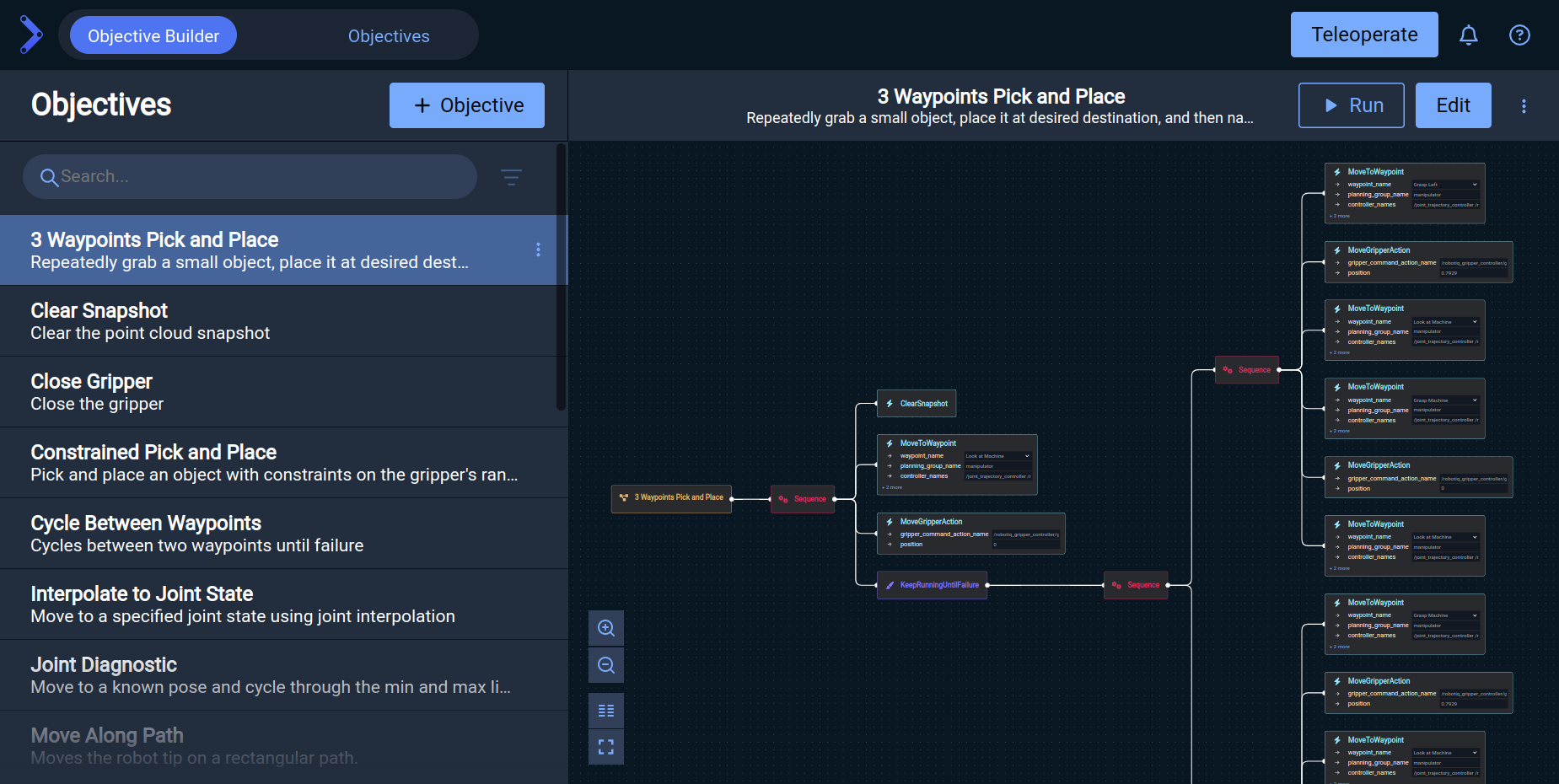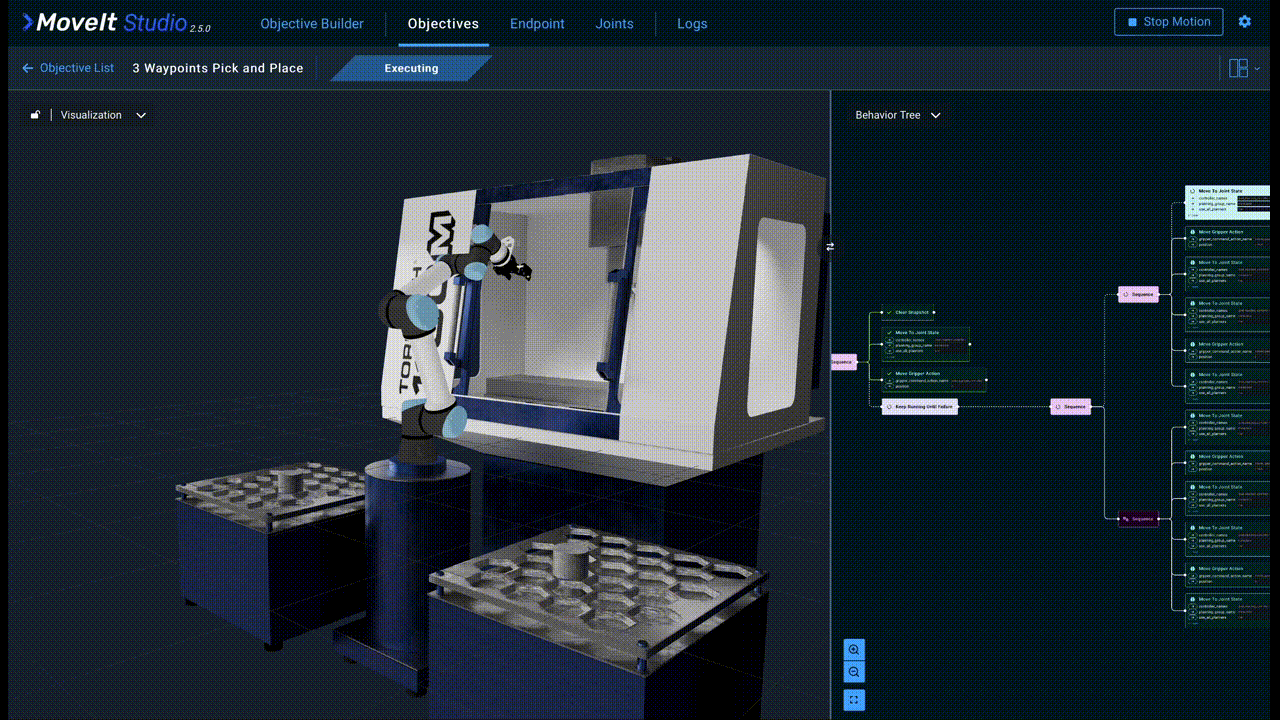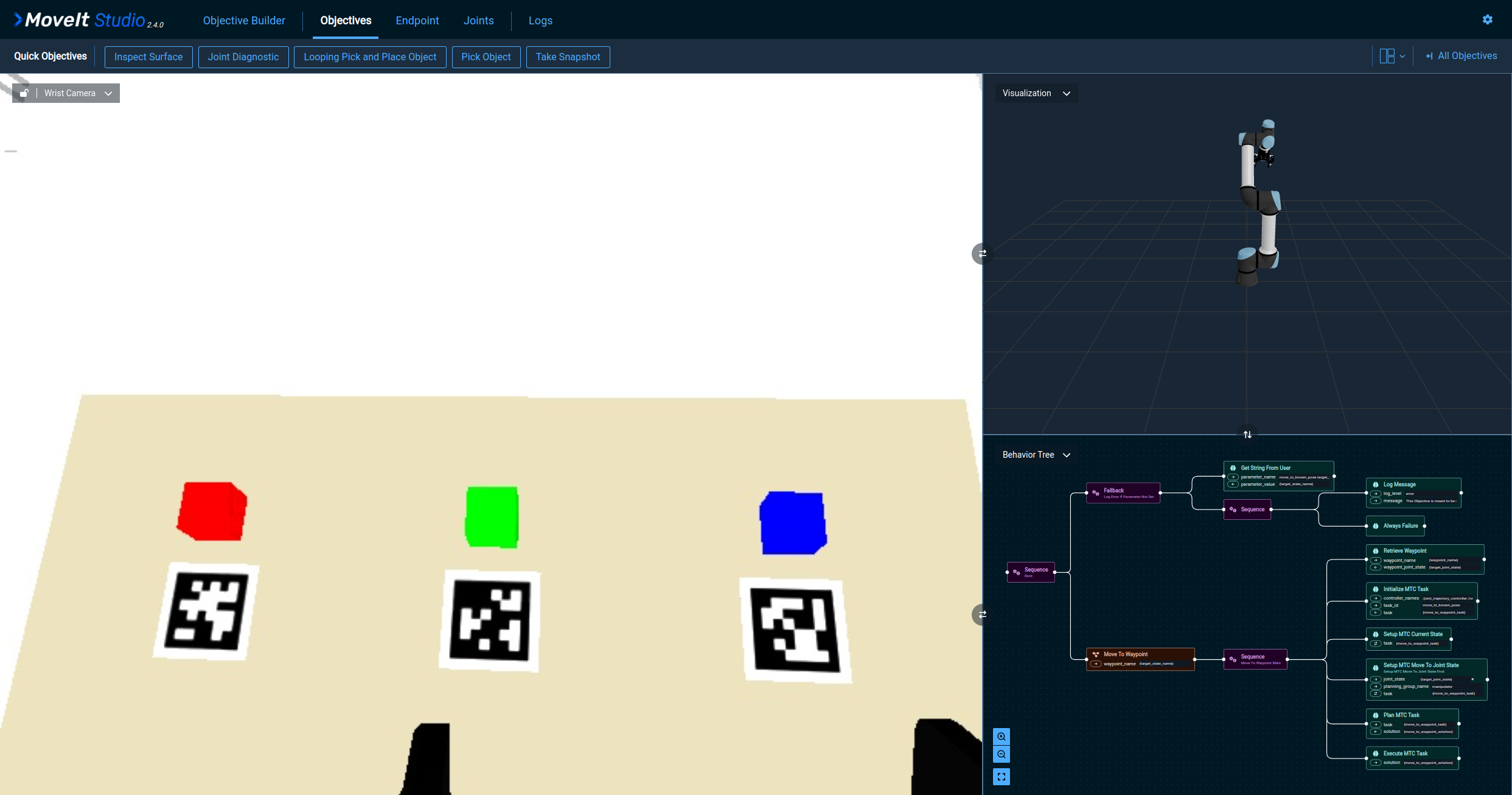Quick Start
A license key is required to run MoveIt Pro; if you do not already have one please contact us for more information. By downloading the MoveIt Pro software you are agreeing to the Terms and Conditions.
Supported Operating Systems
MoveIt Pro runs on Ubuntu natively, but we also support macOS through virtual machines. Choose your computer's operating system from below:
- Ubuntu
- macOS
Ubuntu Desktop 22.04 is our recommended operating system for best performance.
- Note: Our installation process will not install ROS or MoveIt on your host machine, and will not affect any existing ROS workspaces or configurations you may have.
Mac support requires Parallels for hardware virtualization.
- Follow the instructions to install Parallels on your Mac.
- Follow the instructions to install Linux in a Parallels VM, selecting "Download Ubuntu Linux" from the options.
- Once the installation is finished, adjust the VM's allocated Hardware settings:
- Shut down the VM via the "Actions" menu and select "Shut Down"
- From the "Parallels Desktop" application select the "Windows" menu and select "Control Center"
- Open the Settings menu from the gear icon of your Ubuntu virtual machine.
- Select the "Hardware" tab in the configuration window.
- Select "CPU and Memory" and select at least 6 processors and 6 gigabytes of RAM for optimal performance.
- Restart the VM to continue installing MoveIt Pro.
Note: If you are using an existing Parallels VM, be sure to restart your VM before proceeding with installing MoveIt Pro. There is a known issue where your network configuration can become degraded in long-running virtual machines.
For the full system requirements see the Tech Specs.
Docker Installation
MoveIt Pro uses a Docker-based install to make ROS dependency management and compatibility easier. Note we do not currently support Docker Desktop due to its separate network stack. Check if you already have Docker by running in a terminal:
docker run hello-world
If Docker is not installed, click here.
Install Docker by either following the two hyperlinks below, or simply copy paste the below commands into your terminal:
- Docker's convenience script
- Docker's post-installation steps to ensure you can run without
sudoprivileges.
Quick Docker installation commands:
sudo apt-get install curl
curl -fsSL https://get.docker.com -o get-docker.sh
sudo sh get-docker.sh
sudo groupadd docker
sudo usermod -aG docker $USER
sg docker "newgrp $(id -gn)"
To ensure permissions settings take affect for all terminal sessions, log out and back in to your computer.
Finally, verify that you can run Docker commands without sudo.
docker run hello-world
Install MoveIt Pro
Run in a terminal:
curl -LJO https://github.com/PickNikRobotics/moveit_pro_deb/raw/main/picknik/moveit-pro-5.3.2-any.deb
sudo apt install ./moveit-pro-5.3.2-any.debThen follow the prompts to complete installation.
When installation is finished, you can type moveit_pro --help for help using the command line interface.
If you got some concerning apt warnings or errors, click here.
Known Warning You might notice a warning
N: Download is performed unsandboxed as root as file '/home/parallels/moveit-pro-5.3.0-any.deb' couldn't be accessed by user '_apt'. - pkgAcquire::Run (13: Permission denied)
at the end of the install. This warning can be ignored and is not an indicator of install failure. You can continue with the steps below to run and launch MoveIt Pro.
Known Prompt
Running kernel seems to be up to date.
Restarting services...
Daemons using outdated libraries
...
Which services should be restarted?
This is likely because you are using Ubuntu Server, perhaps in Parallels, and can be ignored. Just press enter.
Configure MoveIt Pro
If you already have a MoveIt Pro workspace, you can use moveit_pro configure to configure MoveIt Pro to use your workspace.
Otherwise, you can download an example workspace when you run MoveIt Pro for the first time.
moveit_pro run
When prompted, we recommend you:
- Download the default workspace.
- Remove existing folders, if prompted. Folders that contain user configuration are automatically backed up.
- Rebuild the user workspace.
The recommended, default workspace moveit_studio_ur_ws contains a number of example robots and configurations.
If you already have a MoveIt Pro workspace, you can use moveit_pro configure to configure MoveIt Pro to use your workspace.
After configuring your workspace:
MoveIt Pro will build the necessary Docker image, which requires a ~2 GB download the first time, and might take a few minutes to update and install the package dependencies. Go get a coffee ☕.
Run MoveIt Pro
Next, let's start MoveIt Pro using an example UR5e robot and a non-physics simulator. Since we won't be connected to a real robot for this demonstration, we will launch our optional frontend to visualize and control the robot:
moveit_pro run -c picknik_ur_mock_hw_config
This launches both the MoveIt Pro Runtime in the background, as well as the MoveIt Pro Developer Tool user interface in your default browser at http://localhost/. It should look like this:

You can also run the MoveIt Pro Runtime in headless mode, have it communicate with your application, and visualize things through other tools like RViz:
moveit_pro run -c picknik_ur_mock_hw_config --headless
Troubleshooting
If you are using a firewall, click here.
The Cryptlex licensing servers we use in the US require whitelisting the following IP addresses and web API URL:
52.223.22.7135.71.188.31https://api.cryptlex.com:443
Servers in the EU require whitelisting the following IP addresses and web API URL:
75.2.113.11299.83.149.57https://api.eu.cryptlex.com:443
For more information on offline authentication, please contact us_ directly.
Other issues, questions, or feedback:
- Check out our Troubleshooting Guide
- If provided, use your shared Slack channel to contact support directly.
- Email [email protected]
Start An Example Application
To quickly see an example application (an "Objective") click the "Run" button on the "3 Waypoint Pick and Place" Objective that should be selected by default when the application starts. You should now see the UR5e doing a very simple motion plan, and you can also introspect how it runs by expanding the Behavior Tree window on the right:

Externally Trigger MoveIt Pro using Python API
Typically, MoveIt Pro is integrated into your existing codebase and tech stack - this is possible using our Python API tutorial. It will explain how to use ROS to start and stop Objectives using Python code. Another approach is to communicate using websockets in languages such as JavaScript, Python, Rust, or Java. This is documented in our Websocket Interface tutorial.
Simulate Computer Vision and Physics
An enhanced, new simulator called Mujoco is in beta preview and coming in v6.0!
By default, MoveIt Pro's simulator does not use physics in order to reduce the installation complexity, GPU requirements, and computational load on your computer. However, MoveIt Pro includes an optional Gazebo integration that unlocks more advanced features that are otherwise only available when connected to hardware such as simulated camera feeds. To try out the physics simulator with MoveIt Pro:
-
Close any existing instances of MoveIt Pro running using Ctrl-C on the command line.
-
Only the non-physics simulator was included in default MoveIt Pro. You will need to build the user workspace Docker image, then build the user colcon workspace:
moveit_pro build -
Next, re-launch with the following command to bring up the example UR5e again but this time in Gazebo:
moveit_pro run -c picknik_ur_gazebo_config
You should now see MoveIt Pro with simulated camera feeds that allows our various computer vision algorithms to be tested. For more details see the Gazebo integration tutorial.

Next Steps
To continue exploring MoveIt Pro, check out our next tutorial Running an Objective.
Uninstalling MoveIt Pro
To uninstall MoveIt Pro, but keep your configuration files:
sudo apt remove moveit-pro
To completely remove MoveIt Pro, including all user created configurations, possible older versions, and Docker images, run the following in your home directory:
cd ~
rm -rf moveit_pro/
rm -rf .config/moveit_pro/
rm -rf moveit_studio/
rm -rf .config/moveit_studio/
docker system prune -af
Upgrading MoveIt Pro
First, uninstall your current version of MoveIt Pro using the Uninstalling MoveIt Pro instructions above.
If you are using a previous major release version, you may need to reference the installation instructions from that version of the software - our uninstall instructions have evolved.
Second, follow the Install MoveIt Pro section above.
See the Release and Migration Guides for upgrading an existing robot's MoveIt Pro configuration to a new major version, as there are likely breaking changes that require manual migration steps.